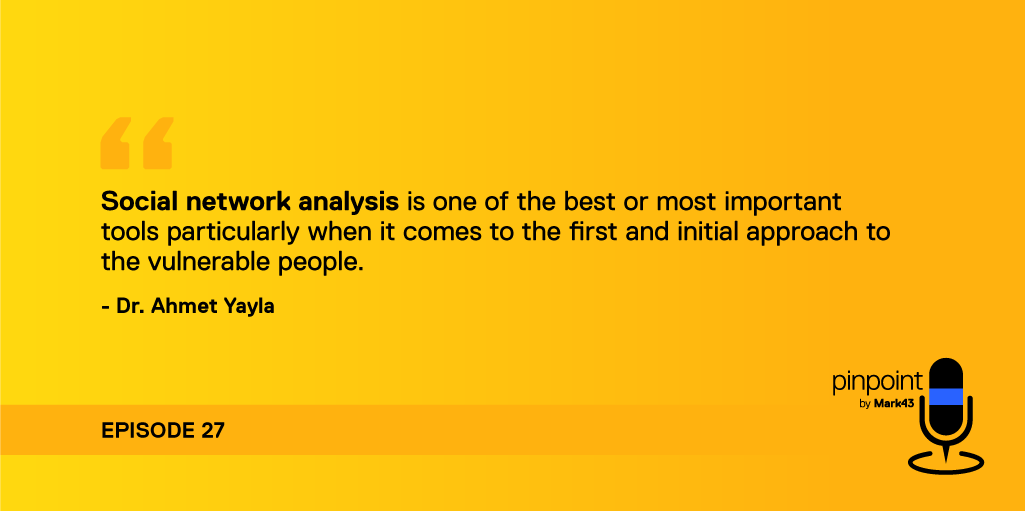Ep 27: Counterterrorism with Minimal Use of Force w/ Dr. Ahmet Yayla
Kristen Goode | 18 August 2020 | 4 minute read

Arrest a teen, and you instantly prime his family members for radicalization and terrorist recruitment.
It’s not because they believe in a radical ideology; it’s because they love their families.
Recruitment is a process.
(function() { var qs, js, q, s, d = document, gi = d.getElementById, ce = d.createElement, gt = d.getElementsByTagName, id = 'soun_der', b = 'https://embed.sounder.fm'; if (!gi.call(d, id)) { js = ce.call(d, 'script'); js.id = id; js.src = b + '/embed.js'; q = gt.call(d, 'script')[0]; q.parentNode.insertBefore(js, q);}})();
The question facing us, then, is, how can we interrupt that process and decrease the numbers of new recruits into terrorist organizations, leading to smaller and less powerful terror groups?
On this episode of Pinpoint, we sit down with Dr. Ahmet Yayla, director of the Center for Homeland Security and assistant professor of homeland security at DeSales University. Dr. Yayla also spent 20 years in counterterrorism with the Turkish National Police.
How Terrorist Organizations Recruit New Members
Everyone’s on social media. Even terrorist recruiters.
Social network analysis is one of the most important tools we have, particularly when it comes to a recruiter’s initial approach to vulnerable people.
That approach can happen in one of two ways:
- Opportunism. This can happen on social media or through close family members and friends around recruiters who provide contacts.
- Geographic targeting. Here, recruiters look for specific talents or like-minded people in a defined region.
Once a recruiter has made an initial approach, the first rule is establishing a bond with the subjects. That means becoming best friends, spending a lot of time together, eating, playing games, maybe even living together. Of course, during that process, the recruiters indoctrinate their subjects, but beyond indoctrination or ideological beliefs, the subject will believe that because of that bond, they cannot say no to their best friend.
Social media, of course, is not a new recruitment platform, but it is an increasingly powerful one. Terrorist organizations have developed and deployed sophisticated technology. Al Qaeda pioneered using different new technologies to promote their activities to carry out propaganda for recruitment purposes. On top of the Hindu Kush mountains, they were using laptops, projectors, and DVD writers, producing training and propaganda videos to distribute all over the world
Of course, ISIS became the technology champion, employing the internet, technologies, and social media. They used those platforms to extend their voices and propaganda far beyond our imagination. These organizations can adapt and use new technology very fast. And the world is often very slow to respond.
Techniques for Interrupting the Terrorist Recruitment Process
We failed historically with ISIS on the internet. Back in the day, you could find tens of thousands of ISIS or al Qaeda videos on YouTube, Twitter, or Facebook at any one time, and nobody was stopping them. Now we are doing a lot better through mutual agreement between the governments and private companies to work together against countering terrorism
But how can you compel private companies to do that? Can you? Should you?
Dr. Yayla says no.
“With my approach,” he told us, “I’m not implying that we should not use force at all, but the priorities should be shifted. I argue that there needs to be a paradigm shift in countering terrorism.”
He says we need to stop swatting mosquitoes and dry up the swamp where they breed. Without a fresh supply of new members, these organizations cannot survive.
And this is exactly where we are failing. The most dangerous approach to law enforcement is waiting for the people to commit crimes, collect evidence against them, take them to court, and lock them up.
Instead of that model, we should look at the source of the problem. We need to ask: Why are people joining these organizations? How can we prevent them from becoming members?
How to Measure Efficiency in Recruitment Prevention
At the end of a defined time period, how do you know if this model was effective? How do you establish criteria to decide whether it is succeeding?
You start with the right objective. Changing an ideology is not the job of law enforcement and intelligence agencies so you can’t look at the numbers of people who move away from a specific type of thinking. But preventing people from becoming violent or joining terrorist organizations can be the role of the police.
The red line here is not ideology. The red line is violence or becoming a member of the terrorist organization because those two lines are basically criminal activities.
So in this case, success means reducing recruitment. Time and reporting, however, can prove challenging. You could produce yearly reports, stating for instance that this subject is not open or vulnerable to new recruitment activities.
Despite what we see about terrorism in the news, the final outcome does not have to be a violent act. It is possible to save young people from recruitment before they ever join forces with a terrorist organization.
This blog post was taken from a Pinpoint podcast interview with Dr. Ahmet Yayla from First Responder’s Wellness Center.
For every episode, click here. Or, for Apple Podcasts users, you can also use this link.






